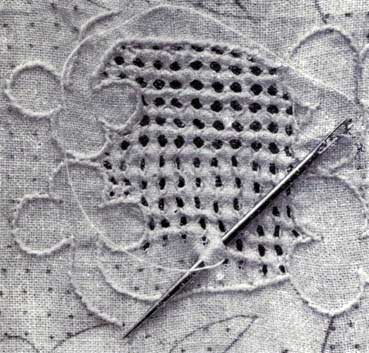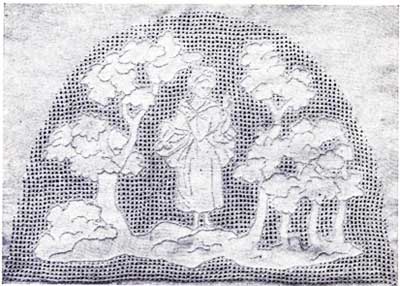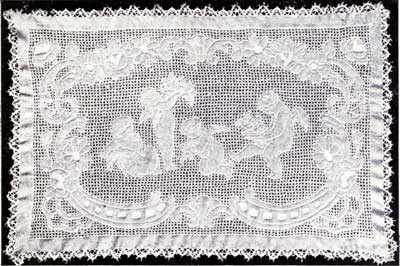Quite a while ago, when I was exploring Lefkara Lace, I heard from a reader who was looking for a resource for Rhodes Embroidery. If you search online for Rhodes Embroidery, most likely you’ll come up with lots of references to Rhodes stitch, but this isn’t what the reader was asking about. She was looking for information on a form of whitework that mimics embroidery originating in Rhodes, and which is basically a pulled thread technique. While I was exploring online the other day, coming across oh-so-many needlework books to meander through, one of the books I came across which I should have mentioned long before this is The Cult of the Needle by Flora Klickmann. Like Elementary Embroidery, the book I pointed out yesterday, this is another gem that is worth downloading and keeping.
I’ve had the PDF version of this book for a long time, nestled in the deep recesses of my folders-within-folders-within-folders on my computer (covered in cobwebs, along with hundreds of other PDFs), but it wasn’t until I was using the handy-dandy “flip through the pages” set-up on the Internet Archive that I made it through every page in the book. And what did I come across?

A whole section on Rhodes Embroidery, including instructions.
Rhodes Embroidery is a somewhat rustic-looking whitework that relies on a pulled thread stitch to form a grid of open holes around the main design element.

Klickmann explains a bit about Rhodes Embroidery:
This work is so called because it is a revival of some old Greek work, done by the peasants of Rhodes Island, of which some very beautiful specimens may be seen in the Victoria and Albert Museum. In this work, however, the effect is produced by the threads being drawn out, but no difficulty caused by the drawing of threads presents itself to the modern worker of Rhodes Embroidery. The threads are simply forced apart with a very coarse needle, and then bound with a strong linen thread.
So that pretty much explains what Rhodes Embroidery basically is. On page 87 of The Cult of the Needle, the author gives a step-by-step method of creating the pulled stitches necessary to create the gridded background on a piece of Rhodes Embroidery.

You don’t see too much of this technique around today. Well, I take that back – there’s plenty of pulled thread embroidery going on these days, but not a lot that is specifically “Rhodes Embroidery.” Do you know of anyone who still does this work? Or of any classes available, or other resources available, for Rhodes Embroidery? If you know of anything, please leave a comment below, to help others find out a little more about this technique!
In the meantime, though, it’s great to have Flora Klickmann’s book online for anyone who wants it, isn’t it?!







Only because of searching YouTube for bobbins lace and other types of lace work did I happen upon Lefkara.
Here is a woman pretty adept with her scissors:
https://www.youtube.com/watch?v=pirrywNR41Q
It’s beautiful work.
The internet has given us us amazing resources to books that would otherwise have been lost to time and dust. Another wonderful collection of free-to-download material is The University of Arizona Textile Library at http://www.cs.arizona.edu/patterns/weaving/books.html It includes a wide variety of topics on textiles from old DMC pattern books, books on techniques, books on private collections, and even antique periodicals. Its search functions take a little getting used to but its well worth the time and energy anf its open to everybody.
puede decirme si recibio mi anterior mensaje sobre Bordados de Cartago????
mary have written three times, but no messages
go … this type of embroidery is overboard, and taught in
Colombia … if you want to know more .. look at my photo albun
of my work .. I can not add links here … or
write me an email and passed the information .. in my
albunm there are details of classes in a private album …
if you want to see him step links, and one appears open
The photo I have taken my shirt .. type and may
observe “bordados de cartago”
album pink cat webshop: nelapx
https://www.youtube.com/watch?v=yaIL0DA5fq0&feature=related
https://www.youtube.com/watch?v=2bNwBG9XzdU
The Therese de Dillmont Complete Encyclopedia of Needlework has a (very) small section on Rhodes embroidery. In the edition that I have, it’s on page 116 and 117, with the images related to it showing a few pages later.
Dear Mary
Thank you for the follow-up on this. I have also found some other sources – Iva Rose had tow books – Punched Work Book by Priscilla, and
Louis XIV Emboridery and Punch Work by Sara Hadley.
I have started my piece, but I am still confused by one thing. Am I correct in thinking that when this was in its heydey, the design, and dots, were all transferred onto the fabric and then stitched? One of the books I read talked about following the dots on the fabric.
I’ll keep you posted on how I manage with the piece. It is in the cue with all the other things I am trying to finish, and learn, this summer (Ukrainian drawn thread, reticello, english paper piecing, hebedo….)
Patricia
you are amazing! this website is awesome.I have reccommended it to my embroidery guild via a newsletter
you are amazing! this website is awesome.I have recommended it to my embroidery guild via a newsletter
G’day Mary,
What a book! Love the mending section. “A childs petticoat made from done-with stocking legs”. And, in those modern times, the washing came back from the laundry tattered and torn because of the harsh modern washing methods. Not like mother’s time when undergarments would last for years. The most problematic was the frills on knickers. And so follows a crochet solution. Oh boy, those were the days.
The Rhodes embroidery is very attractive. It’s like a white on white Assisi work. I’ve always loved both. But of course white on white Assisi really wouldn’t work so here we have it.
Cheers, Kath
In the learning netting section…”Some girls may want to start something really useful and will like to attempt a hammock.” That made me smile…how times have changed! Can you imagine netting an entire hammock???
Thanks for this Mary….I love old craft books. They are not only useful, but give me a giggle too!
Hi, Love your work. I have a question. When you are looking at a pattern, let’s say a floral or something like that, how do you know which kinds of stitches will give that floral the most authentic look. I sometimes look at a pattern and I am not sure which would be the best stitches to use. Any advice on this? Thanks.
Hi, Ofelia – Well, that’s a good question. It helps to have a knowledge of what kind of stitches exist and how they work and what they look like, before considering how to fill in a design. Even if you design your own piece to embroider, when you design it, you normally design it with certain stitches in mind. If you want a realistic looking floral piece, normally, long and short stitch shading is involved, so if that’s what you’re looking for, you might want to research and learn a little bit about long and short stitch shading. Hope that helps! ~MC
Mary ,
Many thanks for the link to The book “the Cult of the Needle”. It is truly a classic.
I had this difficulty with its PDF format,i.e. it would not open the file saying there is a permannt error in it.Do you also get the same message when you open the PDF of the book? I am asking to find out whether this problem is confined to my pc or it is faced by every one. Thankyou once more for furthering my knowledge.
Hi, Sita – It opens fine on my end. You might need to update your software? Hope that helps. ~MC
P.S. Sorry for the typing mistakes, and hope it is not much of a bother.
regards Sita
Thanks Mary, I will try again; I realised that the problem might be at my end when I had the same problem with another PDF,too[subsequently].
Hi Mary, finally was able to open the pdf. I had to change the browser.Thanks for suggestions.
Love your site. Its been a while since I last visited. I hope I get the courage to start a pice using this work.It’s so interesting.
Perhaps you should look at the Sara Hadley #14 booklet, Louis XIV and Punch Work Embroidery. I believe that the punch work is the same as this, under a different name. At the least, it has the same technique of opening the background into a mesh around solid motifs.
beautiful